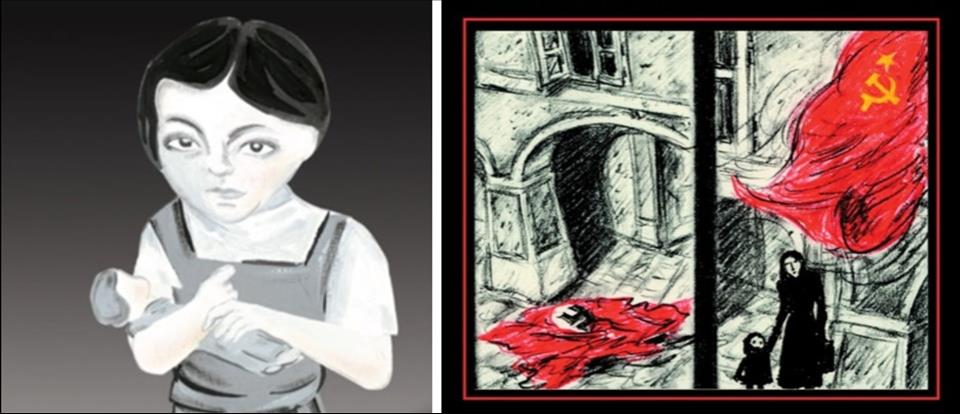
Jewish Women's Illustrated Memoirs Of The Holocaust Cover Matrilineal Relationships
As someone who teaches the Holocaust through literary works, I have found that illustrated graphic memoirs serve as an excellent entry point to this important but difficult subject.
Art Spiegelman is recognized for having launched a new genre of Holocaust memoir with Maus: A Survivor's Tale (1986; 1991), a two-volume graphic work that focused on a father-son relationship.
Lesser known are two groundbreaking graphic works published in 2006 that foreground matrilineal connections and women's survival during the war years: Miriam Katin's We Are on Our Own and Bernice Eisenstein's I Was a Child of Holocaust Survivors .
These memoirs emphasize women's embodied, gendered experience and show their intelligence, agency and resolve.
In documenting women's bravery in the face of Nazi persecution, they help balance the field of Holocaust writing, which still is dominated by the experiences and perspectives of men .
Miriam Katin's We Are on Our Own'We Are on Our Own' by Miriam Katin. (Drawn & Quarterly)
We Are on Our Own recounts how Katin and her mother manage to survive in wartime Hungary. Katin was a small child during the war. She grew up with family stories and, as noted in the coda to her graphic memoir,“could somehow imagine the places and people my mother told me about.”
The memoir traces Katin and her mother's departure from Budapest in 1944 for the Hungarian countryside, where they lived until the end of the war under the guise of a peasant woman with an illegitimate child.
Katin highlights her mother's heroism. First, her mother procures false identity documents for herself and her daughter. She then burns all photographs, letters, books and other documentation that record her true family history. After a loyal housemaid helps fake her death by suicide, she adopts the facade that is essential to her life in open hiding .
Katin also records her mother's experiences of harassment, rape, pregnancy and abortion. Her mother confronts jeering soldiers. She endures repeated rape by a Nazi commandant , knowing the aberrant relationship ensures her survival and her ability to protect her toddler. She offers herself to a Soviet soldier, saving her daughter from untold harm.
And when she becomes pregnant, she overcomes intense anxiety, even thoughts of suicide, to act pragmatically and seek an abortion.
Read more: Why do women change their stories of sexual assault? Holocaust testimonies may provide clues
Bernice Eisenstein's I Was a Child of Holocaust SurvivorsI Was a Child of Holocaust Survivors features Bernice Eisenstein's mother's story of survival, transcribed from a 1995 videotaped interview with Regina Eisenstein for the University of Southern California Shoah Foundation's Visual History Archive .
Eisenstein describes her mother's“unfaltering voice” and“the precision and directness of her words,” which extend over several pages to constitute a presence in her daughter's graphic memoir and in the history she recalls.
In the very act of incorporating“my mother's story as she told it,” Eisenstein is valuing Regina's gendered wartime experience, the judgement she showed then and“the courage she has always possessed.”
Bernice Eisenstein's I Was a Child of Holocaust Survivors was adapted into an animated film by Ann Marie Fleming for the National Film Board.
In September 1939, when the Germans first enter her hometown of Bedzin, Poland , Regina grasps at any opportunity to survive amid the chaos. She understands that being assigned to work duty makes her useful and less of a target. As the only family member with a work permit - she sews uniforms for German soldiers - she is able to hide her relations when the SS stand outside her door.
Towards the end of the war, she herself hides to avoid the death march from Auschwitz . In mid-January 1945, she and a few friends decide to bury themselves under clothing stored in a warehouse. They wait until dark to emerge and race to an abandoned barrack, where they“hid for four more days without food or water. At night, we stepped out and ate snow.”
It is the presence and love of her mother and sister that most succour Regina. In Auschwitz-Birkenau , her mother helps Regina recover from dysentery by giving her a mixture of burned coal and water. When typhus sends Regina into a coma, she later learns her mother visited the hospital to be by her side.
Her mother and sister also prevent Regina from being sent to work on an officer's farm somewhere in Germany. Later, when Regina is transferred from Birkenau to Auschwitz and the three women are forcibly parted, a sense of their abiding bond prevents a descent into hopelessness.
When Regina cannot find language to“describe what it was like when I am reunited with my mother and sister” after liberation, Eisenstein accepts her silence. She characterizes the experience of listening to and watching Regina on videotape as her own“silent journey,” which suggests the degree to which she connects with her mother's experience of falling silent at the close of her 1995 interview.
Breaking silenceIn their graphic memoirs, Katin and Eisenstein break the silence that once shrouded their mothers' suffering.
Each daughter centres her mother's wartime story, asserts her mother's fortitude in the face of affliction and shows her mother's capacity to live with deep wounds.
Each records a singular story in an effort to validate her mother's particular experience under Nazism and to restore women's lived experiences to Holocaust literature and history.
Teachers might consider bringing these memoirs into their classrooms. My own experience confirms that students are moved by these texts and learn a great deal from the stories they tell.

Legal Disclaimer:
MENAFN provides the
information “as is” without warranty of any kind. We do not accept
any responsibility or liability for the accuracy, content, images,
videos, licenses, completeness, legality, or reliability of the information
contained in this article. If you have any complaints or copyright
issues related to this article, kindly contact the provider above.


















Comments
No comment